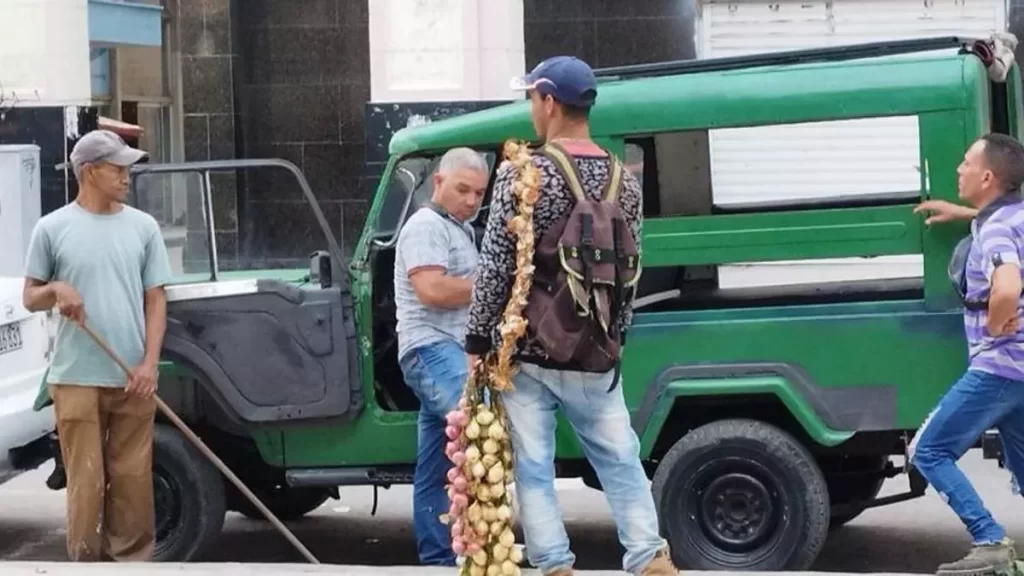
![]() 14ymedio, Natalia López Moya, Havana, March 24, 2024 — Yucca with creole mojo, tamales with a good portion of sofrito on top and the marinade for meat. In each there is an ingredient that leads and surpasses in importance to all the others: garlic. Cuban cuisine basically smells like the aromatic condiment that accompanies a good part of everyday recipes.
14ymedio, Natalia López Moya, Havana, March 24, 2024 — Yucca with creole mojo, tamales with a good portion of sofrito on top and the marinade for meat. In each there is an ingredient that leads and surpasses in importance to all the others: garlic. Cuban cuisine basically smells like the aromatic condiment that accompanies a good part of everyday recipes.
However, ensuring that garlic cloves end up next to the black beans or the boiled malangas is becoming more and more difficult for the pocketbooks of Cuban families. Traditionally sold in the form of bulbs, cloves or strings, garlic is one of this year’s products that has experienced a greater price increase in the agromarkets that 14ymedio monitors every week.
At the beginning of January, on Plaza Boulevard in the city of Sancti Spíritus, a string of garlic reached 1,000 Cuban pesos, and this season’s offer for bulbs and cloves barely appeared on social platforms. “We can’t sell untied garlic because it’s not profitable,” said a seller from a well-known agromarket last January when this newspaper questioned why customers had to buy a complete string of 50 small bulbs.
“Almost everything was seasoned with the popular bulb, and it was also used in herbal teas for many ailments and in skin plasters”
“I put a small bulb in the garlic juicer and there’s plenty of space,” complained a buyer. “It’s not worth peeling because the cloves are so puny that it takes a lot of work; it’s better to crush them all together and use them like that to at least give some flavor to the food.” This is the method to “not give up eating with some garlic.”
With a pension of 1,400 pesos per month, after working for more than 30 years in a company linked to the transport of passengers in Sancti Spíritus, Pascual Gómez recalls that when he was a child, his mother’s hands “smelled of garlic. Almost everything was seasoned with the popular bulb, and it was also used in herbal teas for many ailments and in plasters to apply to the skin,” he explains.
Today, at age 72 and without children to support him inside or outside the Island, Pascual has given up eating with garlic. “It’s not worth paying that amount and having the rest of the month with 400 pesos for everything else,” he explained last January, without imagining that three months later the price would double.
This week, on Plaza Boulevard, a string of fifty garlic bulbs now costs 2,000 pesos, although it reached 2,500 in February and retail options still do not appear. To replace the precious condiment, many appeal to the dehydrated forms that arrive in the country, fundamentally from travelers and the micro, small and medium-sized enterprises (MSMEs).
“I know when someone in my neighborhood is handling good money because when I pass by their house smells of garlic”
On their shelves, the MSMEs often display powdered spices that are “in a lot of demand,” acknowledges the employee of one of these shops located in the colonial center of Sancti Spíritus. “People are looking for granulated garlic, dehydrated onion and also cumin, or a mixture that we offer of lemon, pepper and cilantro.” In the private businesses they sell these seasonings in several formats, even some for a single meal of the Goya brand that “are the most popular,” says the man.
Fresh garlic is left for special occasions and families with more resources. Pascual remembers that his father would say to his mother when she cooked: “Throw it in, throw in the garlic!” to tell her to impregnate the food with its aroma. “Now what people say is: ’Hey, save the garlic, don’t throw so much in,’” he says.
“I know when someone in my neighborhood is handling good money because when I pass by their house smells like garlic,” he says. “The neighbors here had the habit of hooking the string on the kitchen wall to pick off the bulbs when they needed them, but now they hide them because no one wants to be asked for a clove of garlic.”
Translated by Regina Anavy
____________
COLLABORATE WITH OUR WORK: The 14ymedio team is committed to practicing serious journalism that reflects Cuba’s reality in all its depth. Thank you for joining us on this long journey. We invite you to continue supporting us by becoming a member of 14ymedio now. Together we can continue transforming journalism in Cuba.
